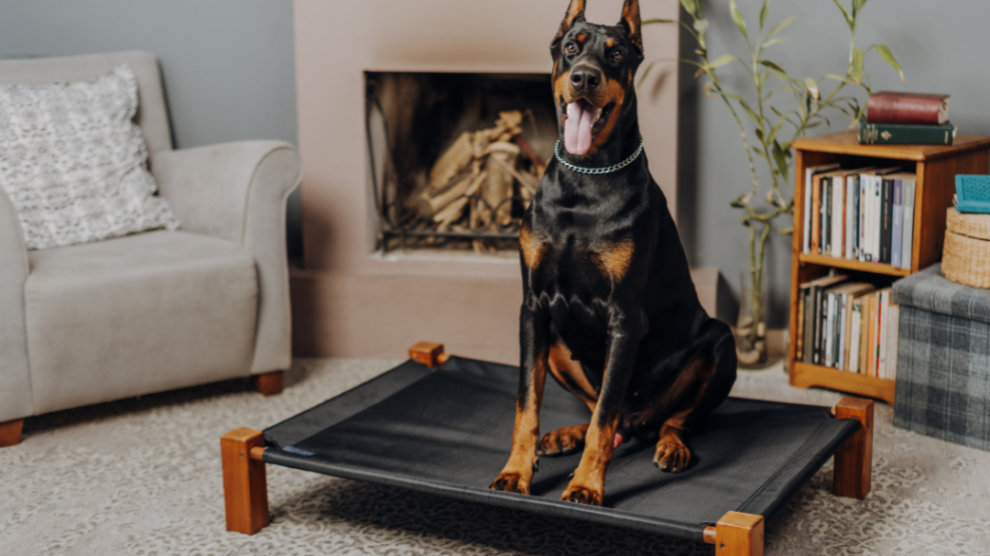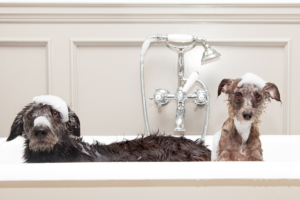Elevate Your Pooch
Choosing the right bed for your dog can greatly improve their comfort, health, and overall well-being. An elevated dog bed, which sits off the ground and provides firm support, is a popular option for many pet owners. These beds come with a raised frame and a breathable mesh or fabric surface, allowing dogs to rest in a more supported and ventilated space. But would an elevated bed be suitable for your dog, and would they enjoy it? In this article, we’ll explore the benefits of elevated dog beds, what types of dogs might enjoy them, and tips for choosing the right one.
What is an Elevated Dog Bed?
An elevated dog bed, also known as a raised dog bed, features a frame that keeps the sleeping surface off the ground. The frame is typically made of metal or plastic, with a stretched fabric or mesh as the bed surface. This design allows air to circulate around the bed, keeping it cooler and helping dogs stay comfortable, especially in warm weather.
Elevated beds are available in various sizes to accommodate dogs of all breeds and are often durable enough to be used indoors or outdoors. This versatility makes them a favorite choice for pet owners looking for a comfortable and practical sleeping solution for their dog.
Benefits of an Elevated Dog Bed
Elevated dog beds offer several advantages over traditional ground-level dog beds:
1. Enhanced Air Circulation
One of the biggest benefits of elevated dog beds is their ability to promote airflow. The raised design allows air to circulate underneath the bed, which helps to regulate your dog’s body temperature. This is especially beneficial in hot climates or during warmer months, as the bed’s ventilation keeps it cool and reduces overheating.
2. Joint and Muscle Support
Elevated dog beds provide firm support that is particularly beneficial for dogs with arthritis, joint pain, or other mobility issues. The raised platform reduces pressure on a dog’s joints and muscles, which can help alleviate pain and improve their quality of rest. The tensioned fabric also offers a stable yet forgiving surface, reducing the strain on your dog’s body as they settle down.
3. Easy to Clean and Maintain
Compared to traditional dog beds with thick padding, elevated dog beds are easier to clean and maintain. The fabric or mesh surface can be wiped down or sprayed with water, and many beds come with machine-washable covers. Since the bed is off the ground, it’s also less likely to collect dirt, dust, and pet hair, making it a hygienic choice for pet owners.
4. Pest and Moisture Protection
Elevated dog beds keep your pet off the ground, reducing their exposure to pests like fleas and ticks, which are often found in grass or dirt. This is especially important if you plan to use the bed outdoors. Additionally, the raised design keeps your dog away from wet or cold ground, protecting them from moisture and preventing them from lying in potentially damp areas.
5. Durability for Outdoor Use
Many elevated dog beds are made from durable, weather-resistant materials, making them suitable for outdoor use. Whether you’re camping, enjoying the backyard, or traveling, an elevated bed can provide your dog with a clean and comfortable place to rest. The sturdy design of these beds means they can withstand rough surfaces and various weather conditions without wearing out quickly.
What Types of Dogs Benefit Most from Elevated Beds?
While elevated beds are generally suitable for dogs of all sizes, certain types of dogs may benefit even more from them:
- Senior Dogs: Older dogs often experience joint pain, arthritis, or mobility issues. Elevated beds provide a firm, supportive surface that relieves pressure on their joints, making it easier for them to get on and off the bed.
- Large or Heavy Dogs: Larger breeds, such as German Shepherds or Labradors, can benefit from the additional support and durability offered by elevated beds. The sturdy frames prevent sagging and provide the necessary support for bigger dogs.
- Dogs with Thick Coats: Dogs with thick or double coats, such as Huskies, may find elevated beds cooler and more comfortable due to the enhanced airflow, helping them stay at a comfortable temperature.
- Active or Athletic Dogs: Dogs that are active or prone to muscle soreness from exercise can benefit from the orthopedic support of an elevated bed, which relieves tension and provides a restful surface.
Will My Dog Like an Elevated Bed?
Whether your dog will enjoy an elevated bed depends on their individual preferences, sleeping habits, and specific needs. Here are some factors to consider:
- Sleeping Position: Dogs that prefer to stretch out or lie flat may enjoy the spacious, firm surface of an elevated bed. However, if your dog loves to nestle or burrow, they might prefer a cushioned bed with raised sides instead.
- Activity Level: If your dog spends time outdoors or is prone to being hot, they might enjoy the cooling effect of an elevated bed. Active dogs who require joint support or are often sore from play and exercise may also benefit from an elevated surface.
- Comfort Preferences: Some dogs prefer soft, cushioned surfaces, while others enjoy firmer beds. An elevated bed offers a firm surface, which may take time for some dogs to adjust to, especially if they’re used to plush bedding.
How to Choose the Right Elevated Dog Bed
When selecting an elevated dog bed, consider the following factors to ensure it meets your dog’s needs and preferences:
- Size and Weight Capacity: Choose a bed that accommodates your dog’s size and weight comfortably. Most manufacturers provide guidelines to help you pick the right size.
- Material and Durability: Look for a bed made from durable materials like steel or aluminum frames and weather-resistant fabric, especially if you plan to use it outdoors. Materials like breathable mesh are ideal for air circulation.
- Ease of Assembly: Many elevated beds are easy to assemble and disassemble, making them convenient for travel. If you plan to use it outdoors or take it on trips, look for a lightweight and portable option.
- Removable and Washable Cover: For easy cleaning, choose a bed with a removable, washable cover. This will keep the bed fresh and free of odors, dirt, or allergens.
- Non-Slip Feet: If you plan to use the bed indoors, non-slip feet or rubber grips will keep the bed stable, especially if your dog tends to move around.
Tips for Introducing Your Dog to an Elevated Bed
To help your dog get comfortable with an elevated bed, introduce it gradually:
- Use Positive Reinforcement: Place treats, toys, or a familiar blanket on the bed to make it inviting. Encourage your dog to explore the bed, offering praise and rewards as they do.
- Start Indoors: If your dog is hesitant, try placing the bed indoors initially, where they feel safe, before moving it outdoors.
- Be Patient: Some dogs may need time to adjust to the firmness of an elevated bed. Give them time, and avoid forcing them onto it.
Woof. Woof.
An elevated dog bed can provide numerous benefits for dogs, including comfort, joint support, and temperature regulation. While not all dogs may immediately take to the raised design, many find elevated beds beneficial, particularly those with mobility issues or thick coats. By considering your dog’s specific needs, size, and preferences, you can select an elevated bed that helps improve their quality of rest and makes them feel safe and comfortable. With the right introduction, an elevated bed could become your dog’s favorite spot to relax and unwind.





























